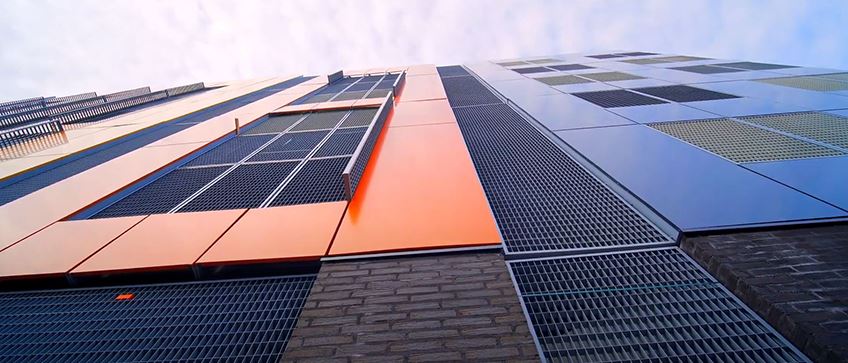The Tapiola swimming pool renovation and extension, Espoo
- Infra
- Parking solutions
- 3853 views
Hangar Parking House, Helsinki
We used takt time production to build an eight-storey parking hall in Vantaa for local residents. How did the new industrial construction method be visible to the various parties?

The Hangaariparkki parking hall is one of YIT’s many takt time production projects in which the parking hall was constructed according to the FLOW model we developed. Thanks to the new model, the parking hall was completed two months ahead of schedule.
The construction of the Hangaariparkki parking hall, which began in January 2021, was already well under way in the summer of 2021. Concrete was cast in the entrance hall of the parking hall, while the second segment on the same floor was waiting for its turn. Workers in other parts of the parking hall had already moved on to technical building systems.
“According to the old model, the entire floor would be cast at the same time, working upwards, after which the surfaces would be finished. Now were working one work phase at a time with overlapping phases. Each phase takes one week”, says YIT Site Manager Anna Hyötylä.
Takt time production is industrial construction. The basic principle is to divide the different work phases of a construction site into separate segments. Construction is progressing one segment at a time. In Hangaariparkki, each segment was approximately 500 square metres.
Industrial construction means only a small change to the customer's everyday life
Takt time production brings with it a new way of doing things. In the Hangaariparkki project, the customer, builder and partners formed a close group that actively monitored the project’s progress.
For the customer, YIT Housing Finland, the actual construction itself went largely unseen, mostly seen in broad strokes.
“For a residential construction location like this, it is important for us to achieve the goals set for the parking hall, which include a correctly timed schedule for residential projects, the correct number of parking spaces and various technical solutions, such as charging systems for electric vehicles. YIT Infrastructure has done well planning the parking hall and carried out the project,” says Jari Hovilehto, Project Manager at YIT Housing Finland.
Hovilehto represents eight different owners in Hangaariparkki and monitors the success of the project.
He is happy that takt time production was being used for the project. The most concrete change was the shorter construction time. Hovilehto says that cooperation with the construction site has been good and that good work has been done in finding solutions according to their wishes.
Takt time production requires planning in advance at the construction site
In the FLOW model, the emphasis shifts to preparatory work to make implementation easier.
In fact, Anna Hyötylä says that partners and subcontractors were more involved than usual in Hangaariparkki. Even at the beginning of the project, more initial information was needed from different parties for planning purposes. For example, subcontractors described different work phases, and work planning played a key role in the whole project. Procurements was also dealt with earlier so that all phases were on schedule.
“The greatest gain from takt time production is the shorter turnaround time. An additional benefit was that we planned together, made changes and kept each other up to date transparently. Quality also improves when we complete a single work phase and check it before moving on to the next one. This results in a better outcome for the customer. Furthermore, takt time production reduces occupational safety risks, as the rules of procedure and their contents have been considered in more detail. With takt time production, we are moving towards a cooperative model with different parties where everyone takes responsibility and commits to the project”, says Hyötylä.
For Hyötylä, takt time production meant just as much work as before. There is more monitoring, but there should be less of it in the future as previous project histories are produced. At Hangaariparkki, she was already thinking about the order of the next work phase.

Standardised manufacturing
Markku Räisänen, Design Director at Betset Oy, is participating in a takt time production project for the first time.
“Our role was to produce pre-cast concrete elements and generate data streams for YIT. The key thing about Hangaariparkki was that our data is linked to and supported by YIT’s processes. That's what the FLOW concept is all about.”
For Betset, takt time production was reflected in the production schedule for the elements.
“For this project, the aim was to carry the process out earlier and to plan and make orders related to material needs sooner. We did development work for the entire FLOW project. Real-time monitoring of production and orders has also been easy thanks to our Betset Linker app, so transparency has been better than usual,” says Räisänen.
Räisänen says that another focus of Hangaariparkki was the standardisation of pre-cast concrete elements. They considered which sections and configurations could be standardised so that they could achieve an affordable outcome and ensure industrial production from one site to another.
Räisänen praises Hangaariparkki’s overall development work.
Räisänen believes that the new model will affect predictability and create smoother planning and information flow. Future solutions will certainly be cost-efficient. Räisänen also does not see any restrictions for using the FLOW model in different types of construction.
“The next step is to utilise model-based visualisation, which involves model-based data streams. This allows the site manager to use the model to pick out the elements they want to order and to be delivered within three days, for example.”
“This is the right direction to take construction in. We have also developed our own process to standardise production and to ensure that data moves and that different construction site processes are seamlessly linked overall.”
No desire to go back to the way things were
New working methods always have room for improvement. The order and content of work are constantly being developed. In the future, Hyötylä will ensure that lessons are learned from disruptions and that potential mistakes are not repeated.
Even though the YIT's method that she used at the site is still new, she would not go back to the old one.
“Visualisations and continuous monitoring are always in front of me, and I know what the current situation is. You also learn from history data.”
In future takt time projects, everyone will already know their responsibilities. All of this also affects attitudes. Hyötylä has been happy to see that the model has also been adopted at the construction site: the employees was talking about which segment each of them are going to work on.
Details
- Country
- Finland
- Year
- 2021
- Project status
- Completed
- Business segment
- Infra






